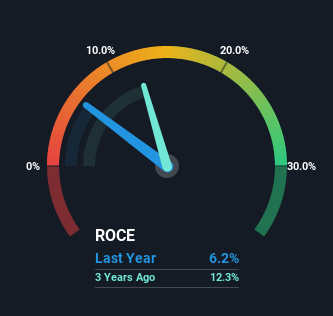
If you're not sure where to start when looking for the next multi-bagger, there are a few key trends you should keep an eye out for. Typically, we'll want to notice a trend of growing return on capital employed (ROCE) and alongside that, an expanding base of capital employed. Basically this means that a company has profitable initiatives that it can continue to reinvest in, which is a trait of a compounding machine. However, after investigating UniFirst (NYSE:UNF), we don't think it's current trends fit the mold of a multi-bagger.
Return On Capital Employed (ROCE): What Is It?
Just to clarify if you're unsure, ROCE is a metric for evaluating how much pre-tax income (in percentage terms) a company earns on the capital invested in its business. The formula for this calculation on UniFirst is:
Return on Capital Employed = Earnings Before Interest and Tax (EBIT) ÷ (Total Assets - Current Liabilities)
0.062 = US$134m ÷ (US$2.4b - US$244m) (Based on the trailing twelve months to August 2022).
Thus, UniFirst has an ROCE of 6.2%. Ultimately, that's a low return and it under-performs the Commercial Services industry average of 9.3%.
See our latest analysis for UniFirst

In the above chart we have measured UniFirst's prior ROCE against its prior performance, but the future is arguably more important. If you'd like to see what analysts are forecasting going forward, you should check out our free report for UniFirst.
What Can We Tell From UniFirst's ROCE Trend?
In terms of UniFirst's historical ROCE movements, the trend isn't fantastic. Around five years ago the returns on capital were 10%, but since then they've fallen to 6.2%. Meanwhile, the business is utilizing more capital but this hasn't moved the needle much in terms of sales in the past 12 months, so this could reflect longer term investments. It's worth keeping an eye on the company's earnings from here on to see if these investments do end up contributing to the bottom line.
What We Can Learn From UniFirst's ROCE
To conclude, we've found that UniFirst is reinvesting in the business, but returns have been falling. And with the stock having returned a mere 18% in the last five years to shareholders, you could argue that they're aware of these lackluster trends. As a result, if you're hunting for a multi-bagger, we think you'd have more luck elsewhere.
If you want to continue researching UniFirst, you might be interested to know about the 1 warning sign that our analysis has discovered.
While UniFirst may not currently earn the highest returns, we've compiled a list of companies that currently earn more than 25% return on equity. Check out this free list here.
New: AI Stock Screener & Alerts
Our new AI Stock Screener scans the market every day to uncover opportunities.
• Dividend Powerhouses (3%+ Yield)
• Undervalued Small Caps with Insider Buying
• High growth Tech and AI Companies
Or build your own from over 50 metrics.
Have feedback on this article? Concerned about the content? Get in touch with us directly. Alternatively, email editorial-team (at) simplywallst.com.
This article by Simply Wall St is general in nature. We provide commentary based on historical data and analyst forecasts only using an unbiased methodology and our articles are not intended to be financial advice. It does not constitute a recommendation to buy or sell any stock, and does not take account of your objectives, or your financial situation. We aim to bring you long-term focused analysis driven by fundamental data. Note that our analysis may not factor in the latest price-sensitive company announcements or qualitative material. Simply Wall St has no position in any stocks mentioned.
About NYSE:UNF
UniFirst
Provides workplace uniforms and protective work wear clothing in the United States, Europe, and Canada.
Flawless balance sheet with proven track record.
Similar Companies
Market Insights
Community Narratives



